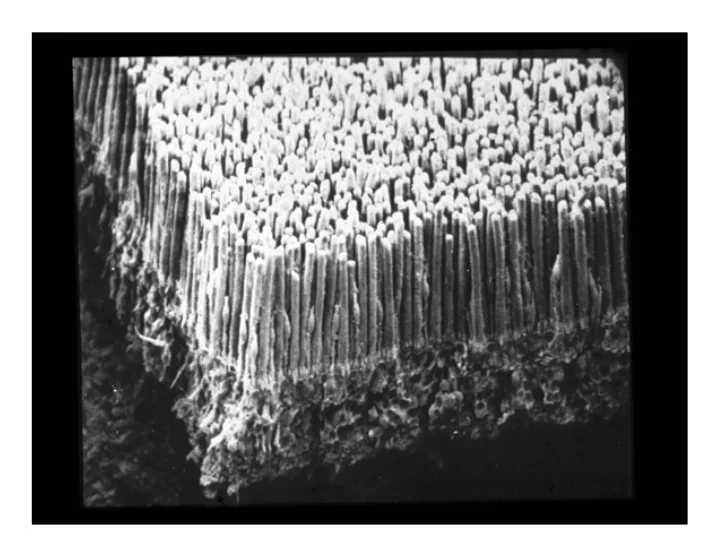

FREQUENCY OF SEEING EXPERIMENTS (Hecht, Shlaer and Pirenne, 1942) 100 80 target = 2 Θ 60 % seen = 7 Θ 40 fixation = 12 Θ point 20 target covers ~500 rods 0 10 100 photons at cornea CONCLUSION: Θ = 5-7 photons absorbed spread over 500 rods PROBLEM: No way to account for false positives (noise)
Signal and noise distributions and false positives (on board)
IMPLICATIONS OF BEHAVIORAL SENSITIVITY • phototransduction - single photons reliably transduced rod cone • synaptic transmission - reliable transmission of single photon responses rod cone bipolar bipolar cell cell AII ganglion amacrine • neural coding cell cell - absorption of a single photon alters optic nerve activity But the task of the retina is in fact more challenging ...
CONVERGENCE AND SPARSE SIGNALING IN MAMMALIAN RETINA keep discard • At visual threshold photons < 0.1% of the rods contribute signals while all rods generate noise • Under these conditions averaging is a disaster - instead requires separation of signal from noise • General problem in nervous system What is optimal readout of array of detectors when small fraction active? Baylor et al., 1984 van Rossum and Smith, 1998 Field and Rieke, 2002
CONVERGENCE AND SPARSE SIGNALING IN MAMMALIAN RETINA keep discard • At visual threshold photons < 0.1% of the rods contribute signals while all rods generate noise • Under these conditions averaging is a disaster - instead requires separation of signal from noise • General problem in nervous system • Sizeable behavioral consequences for getting this right! Baylor et al., 1984 van Rossum and Smith, 1998 Field and Rieke, 2002
RODS GENERATE PHOTON-LIKE NOISE EVENTS AND CONTINUOUS NOISE ave photon-like noise event ave single photon response photon-like noise event 1 pA continuous noise 0.2 sec 1 pA 0 20 40 60 time (sec) Baylor et al., 1984 Greg Field
• Mouse rod-rod bipolar signal transfer is keep nonlinear. - dependence of response on flash discard strength - discreteness of dim flash response • Nonlinear signal transfer eliminates or severely attenuates majority of rod’s single photon responses. • Rejection of noise more than compensates loss of signal - thus rod bipolars provide near-optimal readout of rod signals near visual threshold.
THE ROD BIPOLAR PATHWAY rod cone rod cone bipolar bipolar cell cell AII ganglion amacrine cell cell
DIM FLASH RESPONSES OF RODS GROW LINEARLY WITH FLASH STRENGTH 0 log(R/R max ) -1 -5 pA -10 -15 -2 0.0 0.2 0.4 0.6 0 1 sec log(Rh*) rods rod bipolar why log-log? Field and Rieke, 2002
RESPONSES OF ROD BIPOLARS BUT NOT RODS GROW SUPRALINEARLY WITH FLASH STRENGTH 0 log(R/R max ) -1 -5 pA -10 -15 -2 0.0 0.2 0.4 0.6 0 1 rods sec log(Rh*) 0 0 rod bipolar log(R/R max ) -50 pA -1 -100 -150 -2 0.0 0.2 0.4 0.6 -1 0 1 time (sec) log(Rh*/rod) Field and Rieke, 2002
keep photocurrent Does rod-rod bipolar signal transfer separate 1 pA throw away rod signal and noise? flash times 6 8 10 12 14 time (sec)
MOUSE ROD SINGLE PHOTON RESPONSES ARE PARTIALLY OBSCURED BY NOISE 60 # responses 2 pA 0.6 Rh* 40 20 0 0.0 0.2 0.4 0.6 0 2 4 sec amplitude rods rod bipolar Field and Rieke, 2002
ROD BIPOLARS GENERATE DISCRETE RESPONSES TO DIM FLASHES 60 # responses 2 pA 0.6 Rh* 40 20 0 0.0 0.2 0.4 0.6 0 2 4 sec amplitude rods 8 0.6 Rh*/rod rod # responses 6 bipolar 20 pA 4 2 0 0.0 0.2 0.4 0.6 0 2 4 sec amplitude Field and Rieke, 2002
keep • Mouse rod-rod bipolar signal transfer is discard nonlinear. • Nonlinear signal transfer eliminates or severely attenuates majority of rod’s single photon responses. • Rejection of noise more than compensates loss of signal - thus rod bipolars provide near-optimal readout of rod signals near visual threshold.
MODEL FOR ROD-ROD BIPOLAR SIGNAL TRANSFER probability rods gain nonlinearity amplitude Σ sum # responses amplitude predict nonlinearity and discreteness of rod bipolar response flash strength amplitude
Signal and noise distributions and discrimination (on board)
keep • Mouse rod-rod bipolar signal transfer is discard nonlinear. • Nonlinear signal transfer eliminates or severely attenuates majority of rod’s single photon responses. • Rejection of noise more than compensates loss of signal - thus rod bipolars provide near-optimal readout of rod signals near visual threshold.
DISTRIBUTION OF ROD RESPONSES AT VISUAL THRESHOLD Rod experiments (~1 Rh*) Visual threshold (0.0001 Rh*) signal noise nonlinearity 1.0 1.0 10 -2 10 -2 nonlinearity gain probability 10 -4 10 -4 0.5 0.5 10 -6 10 -6 10 -8 10 -8 0.0 0.0 -1 0 1 2 -1 0 1 2 amplitude amplitude Field and Rieke, 2002
Recommend
More recommend